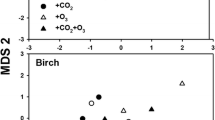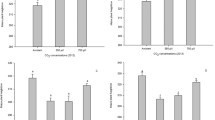Abstract
Elevated concentrations of atmospheric CO2 are likely to interact with other factors affecting plant physiology to alter plant chemical profiles and plant–herbivore interactions. We evaluated the independent and interactive effects of enriched CO2 and artificial defoliation on foliar chemistry of quaking aspen (Populus tremuloides) and sugar maple (Acer saccharum), and the consequences of such changes for short-term performance of the gypsy moth (Lymantria dispar). We grew aspen and maple seedlings in ambient (~360 ppm) and enriched (650 ppm) CO2 environments at the University of Wisconsin Biotron. Seven weeks after budbreak, trees in half of the rooms were subjected to 50% defoliation. Afterwards, foliage was collected for chemical analyses, and feeding trials were conducted with fourth-stadium gypsy moths. Enriched CO2 altered foliar levels of water, nitrogen, carbohydrates, and phenolics, and responses generally differed between the two tree species. Defoliation induced chemical changes only in aspen. We found no significant interactions between CO2 and defoliation for levels of carbon-based defenses (phenolic glycosides and tannins). CO2 treatment altered the performance of larvae fed aspen, but not maple, whereas defoliation had little effect on performance of insects. In general, results from this experimental system do not support the hypothesis that induction of carbon-based chemical defenses, and attendant effects on insects, will be stronger in a CO2-enriched world.
Similar content being viewed by others
REFERENCES
Baldwin, I. T. 1994. Chemical changes rapidly induced by folivory, pp. 1–23, in E. A. Bernays (ed.). Insect-Plant Interactions. CRC Press, Boca Raton, Florida.
Baldwin, I. T., and Schultz, J. C. 1983. Rapid changes in tree leaf chemistry induced by damage: Evidence for communication between plants. Science 221:277–279.
Bryant, J. P., Chapin, F. S., III, and Klein, D. R. 1983. Carbon/nutrient balance of boreal plants in relation to vertebrate herbivory. Oikos 40:357–368.
Bryant, J. P., Danell, K., Provenza, F., Reichardt, P. B., Clausen, T. A., and Werner, R. A. 1991. Effects of mammal browsing on the chemistry of deciduous woody plants, pp. 135–154, in D. W. Tallamy and M. J. Raupp, (eds.). Phytochemical Induction by Herbivores. John Wiley & Sons, New York.
Bryant, J. P., Reichardt, P. B., Clausen, T. P., and Werner, R. A. 1993. Effects of mineral nutrition on delayed inducible resistance in Alaska paper birch. Ecology 74:2072–2084.
Ceulemans, R., and Mousseau, M. 1994. Effects of elevated atmospheric CO2 on woody plants. New Phytol. 127:425–446.
Clausen, T. P., Reichardt, P. B., Bryant, J. P., Werner, R. A., Post, K., and Frisby, K. 1989. A chemical model for short-term induction in quaking aspen (Populus tremuloides) foliage against herbivores. J. Chem. Ecol. 15:2335–2346.
Curtis, P. S. 1996. A meta-analysis of leaf gas exchange and nitrogen in trees grown under elevated carbon dioxide. Plant Cell Environ. 19:127–137.
Fajer, E. D., Bowers, M. D., and Bazzaz, F. A. 1991. Performance and allocation patterns of the perennial herb, Plantago lanceolata, in response to simulated herbivory and elevated CO2 environments. Oecologia 87:37–42.
Farmer, E. E., and Ryan, C. A. 1990. Interplant communication: Airborne methyl jasmonate induces synthesis of proteinase inhibitors in plant leaves. Proc. Natl. Acad. Sci. U.S.A. 87:7713–7716.
Hemming, J. D. C., and Lindroth, R. L. 1995. Intraspecific variation in aspen phytochemistry: Effects on performance of gypsy moths and forest tent caterpillars. Oecologia 103:79–88.
Hendrey, G. R. 1993. FACE: Free-Air CO2 Enrichment for Plant Research in the Field. CRC Press, Boca Raton, Florida.
Herms, D. A., and Mattson, W. J. 1992. The dilemma of plants: To grow or defend. Q. Rev. Biol. 67:283–335.
Houghton, J. T., Meira Filho, L. G., Callander, B. A., Harris, N., Kattenberg, A., and Maskell, K. (eds.). 1996. Climate Change 1995. The Science of Climate Change. Cambridge University Press, Cambridge.
Hunter, M. D., and Schultz, J. C. 1995. Fertilization mitigates chemical induction and herbivore responses within damaged oak trees. Ecology 76:1226–1232.
Hwang, S.-Y., and Lindroth, R. L. 1997. Clonal variation in foliar chemistry of aspen: Effects on gypsy moths and forest tent caterpillars. Oecologia 111:99–108.
Inoue, K. H., and Hagerman, A. E. 1988. Determination of gallotannin with rhodanine. Anal. Biochem. 169:363–369.
Johnson, R. H., and Lincoln, D. E. 1991. Sagebrush carbon allocation patterns and grasshopper nutrition: The influence of CO2 enrichment and soil mineral limitation. Oecologia 87:127–134.
Jones, C. G., Hare, J. D., and Compton, S. J. 1989. Measuring plant protein with the Bradford assay. 1. Evaluation and standard method. J. Chem. Ecol. 15:979–992.
Karban, R., and Baldwin, I. T. 1997. Induced Responses to Herbivory. University of Chicago Press, Chicago.
Kinney, K. K., and Lindroth, R. L. 1997. Responses of three deciduous tree species to atmospheric CO2 and soil NO− 3 availability. Can. J. For. Res. 27:1–10.
Kinney, K. K., Lindroth, R. L., Jung, S. M., and Nordheim, E. V. 1997. Effects of CO2 and NO− 3 availability on deciduous trees: Phytochemistry and insect performance. Ecology 78:215–230.
Kruger, E. L., Volin, J. C., and Lindroth, R. L. 1998. Influences of atmospheric CO2 enrichment on the responses of sugar maple and trembling aspen to defoliation. New Phytol. In press.
Lang, C. A. 1958. Simple microdetermination of Kjeldahl nitrogen in biological materials. Anal. Chem. 30:1692–1694.
Lawler, I. R., Foley, W. J., Woodrow, I. E., and Cork, S. J. 1997. The effects of elevated CO2 atmospheres on the nutritional quality of Eucalyptus foliage and its interaction with soil nutrient and light availability. Oecologia 109:59–68.
Lerdau, M., Litvak, M., and Monson, R. 1994. Plant chemical defense: Monoterpenes and the growth-differentiation balance hypothesis. TREE 9:58–61.
Lincoln, D. E., Fajer, E. D., and Johnson, R. H. 1993. Plant-insect herbivore interactions in elevated CO2 environments. TREE 8:64–68.
Lindroth, R. L. 1996. CO2-mediated changes in tree chemistry and tree-Lepidoptera interactions, pp. 105–120, in G. W. Koch and H. A. Mooney, (eds.). Carbon Dioxide and Terrestrial Ecosystems. Physiological Ecology Series. Academic Press, San Diego.
Lindroth, R. L., Kinney, K. K., and Platz, C. L. 1993. Responses of deciduous trees to elevated atmospheric CO2: Productivity, phytochemistry and insect performance. Ecology 74:763–777.
Lindroth, R. L., Klein, K. A., Hemming, J. D. C., and Feuker, A. M. 1997a. Variation in temperature and dietary nitrogen affect performance of the gypsy moth (Lymantria dispar L.). Physiol. Entomol. 22:55–64.
Lindroth, R. L., Roth, S., Kruger, E. L., Volin, J. C., and Koss, P. A. 1997b. CO2-mediated changes in aspen chemistry: Effects on gypsy moth performance and susceptibility to virus. Global Change Biol. 3:279–289.
McGuire, A. D., Melillo, J. M., and Joyce, L. A. 1995. The role of nitrogen in the response of forest net primary production to elevated atmospheric carbon dioxide. Annu. Rev. Ecol. Syst. 26:473–503.
Mole, S. 1994. Trade-offs and constraints in plant-herbivore defense theory: A life-history perspective. Oikos 71:3–12.
ODell, T. M., Butt, C. A., and Bridgeforth, A. W. 1985. Lymantria dispar, pp. 355–367, in P. Singh and R. F. Moore, (eds.). Handbook of Insect Rearing, Vol. 2. Elsevier, New York.
Parkinson, J. A., and Allen, S. E. 1975. A wet oxidation procedure suitable for the determination of nitrogen and mineral nutrients in biological material. Commun. Soil Sci. Plant Anal. 6:1–11.
Pearson, M., and Brooks, G. L. 1996. The effect of elevated CO2 and grazing by Gastrophysa viridula on the physiology and regrowth of Rumex obtusifoius. New Phytol. 133:605–616.
Porter, L. J., Hrstich, L. N., and Chan, B. G. 1986. The conversion of procyanidins and prodelphinidins to cyanidin and delphinidin. Phytochemistry 25:223–230.
Reichardt, P. B., Chapin, F. S., III, Bryant, J. P., Mattes, B. R., and Clausen, T. P. 1991. Carbon/nutrient balance as a predictor of plant defense in Alaskan balsam poplar: Potential importance of metabolite turnover. Oecologia 88:401–406.
Roth, S. K., and Lindroth, R. L. 1995. Elevated atmospheric CO2: Effects on phytochemistry, insect performance and insect parasitoid interactions. Global Change Biol. 1:173–182.
Roth, S., McDonald, E. P., and Lindroth, R. L. 1997. Interactions between atmospheric CO2 and soil water availability: Consequences for tree-insect interactions. Can. J. For. Res. 27:1281–1290.
Roth, S., Lindroth, R. L., Volin, J. C., and Kruger, E. L. 1998. Enriched atmospheric CO2 and defoliation: Effects on tree chemistry and insect performance. Global Change Biol. 4:419–430.
SAS Institute, Inc. 1989. SAS User's Guide: Statistics. Version 6 edition. SAS Institute Inc., Cary, North Carolina.
Sheppard, C. A., and Friedman, S. 1992. Effect of dietary nitrogen on gypsy moth larval nutritional indices, development and lipid content. Entomol. Exp. Appl. 64:269–280.
Stitt, M. 1991. Rising CO2 levels and their potential significance for carbon flow in photosynthetic cells. Plant Cell Environ. 14:741–762.
Tallamy, D. W., and Raupp, M. J. (eds.). 1991. Phytochemical Induction by Herbivores. John Wiley & Sons, New York.
Watt, A. D., Whittaker, J. B., Docherty, M., Brooks, G., Lindsay, E., and Salt, D. T. 1995. The impact of elevated atmospheric CO2 on insect herbivores, pp. 197–217, in R. Harrington and N. E. Stork (eds.). Insects in a Changing Environment. Academic Press, New York.
Welter, S. C. 1989. Arthropod impact on plant gas exchange, pp. 135–150, in E. A. Bernays (ed.). Insect-Plant Interactions. CRC Press, Boca Raton, Florida.
Wilsey, B. J., Coleman, J. S., and McNaughton, S. J. 1997. Effects of elevated CO2 and defoliation on grasses: A comparative ecosystem approach. Ecol. Appl. 7:844–853.
Wilson, T. C., and Hagerman, A. E. 1990. Quantitative determination of ellagic acid. J. Agric. Food Chem. 38:1678–1683.
Yates, J. L., and Peckol, P. 1993. Effects of nutrient availability and herbivory on polyphenolics in the seaweed Fucus vesiculosus. Ecology 74:1757–1766.
Author information
Authors and Affiliations
Rights and permissions
About this article
Cite this article
Lindroth, R.L., Kinney, K.K. Consequences of Enriched Atmospheric CO2 and Defoliation for Foliar Chemistry and Gypsy Moth Performance. J Chem Ecol 24, 1677–1695 (1998). https://doi.org/10.1023/A:1020820612833
Issue Date:
DOI: https://doi.org/10.1023/A:1020820612833




